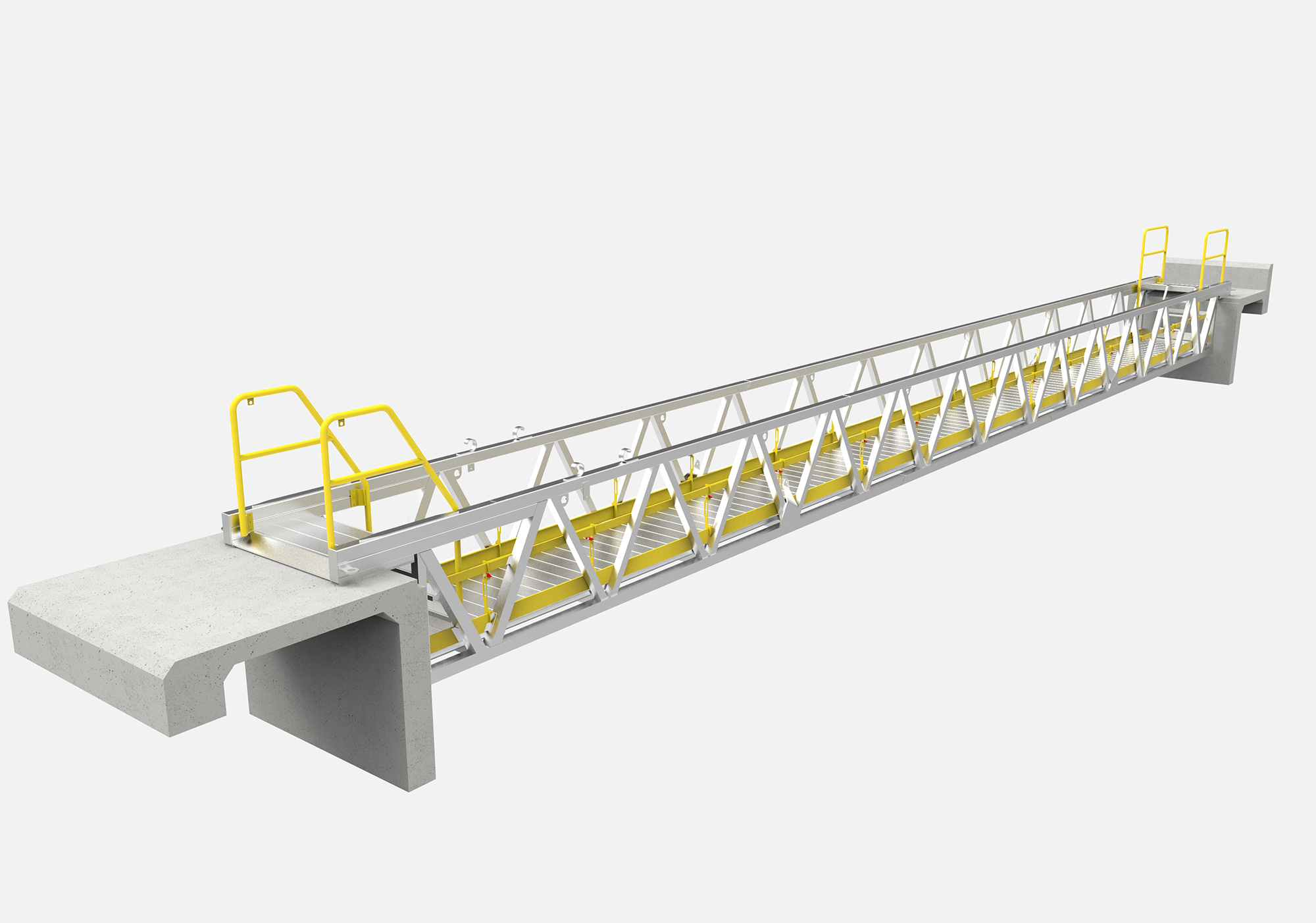The MAADI Group engineering firm, Montréal, Québec, has installed twin aluminum pedestrian service bridges that are placed over the smelting furnaces of the Rio Tinto Alcan facility in Jonquière, Québec, Canada.
December 17, 2012—MONTREAL, CANADA – The structurally strong, yet lightweight footbridges are constructed with virtually maintenance-free aluminum components, allowing workers flexibility in servicing the various furnaces at Rio Tinto Alcan’s Jonquière smelter.
The service bridges are site-specific for this industrial application, which requires the bridges to be lower than the access level, so that they are hanging on the top chord, with access onto the bridge made via a short stairway. Servicing the furnaces requires the bridges to have side entry openings with removable barriers that enable worker access to the service areas of the smelting furnaces. When a furnace requires service, the bridge is placed next to it and the worker gains access by removing the security barrier.
This innovative service bridge design’s aluminum structure has an overall length of 20 meters (65 feet, 7 inches) and a clear width of 1.13 meters (44-1/2 inches). A specially-designed ABS plus red-colored latching system developed by MAADI Group,and printed in-house using fusion deposit modeling (FDM),securely locks the aluminum barriers closed. The MAADI Group recently acquired a Dimension 1200es Series 3D Printer that uses ABS plus as bare material. ABS plus is an ideal material for conceptual protoyping by MAADI Group, using design verification through direct digital manufacturing. The marriage of ABS plus with FDM technology gives MAADI design engineers the ability to create functional parts such as the latch system from digital files that are strong (Fy 5400 psi), with a smooth finish and more feature detail.
Canadian building codes for working at high elevations prescribe the use of fall arrest equipment. MAADI engineers installed an anchoring system to attach and secure Rio Tinto Alcan’s fall arrest equipment to the service bridges at every barrier via an aluminum ring that is welded between the diagonal members on each side of the barrier. In addition, each bridge is electrically grounded to the smelting furnaces for every service procedure, as part of Rio Tinto Alcan’s security and safety requirements.
The ultra-light and corrosion-free aluminum service bridges can be placed over each smelting furnace as needed at various times. An aluminum structure was chosen for its convenience,non-magnetic properties, ease of use, durability, and quick set-up and take-down. MAADI Group CEO Alex de la Chevrotière, P.E. notes: “Our aluminum service bridges are an efficient way to provide quick and easy access to the smelting furnaces, which need regularly-scheduled service. This type of industrial application is a great example of aluminum’s structural design versatility.”
“Routine maintenance on the furnaces is accomplished in less time, without problems,” de la Chevrotière said, “The lightweight aluminum truss framework, removable guardrail barriers and decking sections are assembled securely in minimal time, with the benefit of easily attaching fall arrest equipment and accessories. Workers release the ABS plus latches to open the side barriers, secure the safety equipment with the anchors, accomplish their work on the furnace, then reverse the process and re-secure the barriers in place when exiting the bridge. The convenience of a mobile service bridge greatly increases efficiency, while maintaining the highest level of safety and security.”
A comparative Total Cost of Ownership (TCO) study, conducted by Deloitte Inc. for MAADI Group engineers, demonstrates that civil engineering projects gain many cost benefits by using aluminum components, since they require virtually no maintenance and retain high value as recyclable material.
De la Chevrotière explains, “The TCO approach reveals aluminum’s lower overall cost over time. Since aluminum is corrosion free, aluminum bridges are truly maintenance free, removing the added expense of galvanizing or painting steel due to rust. Aluminum has the unique advantage of being two-thirds lighter than steel, yet just as strong, and is impervious to corrosion and harsh chemicals. At the end of its useful life, the aluminum bridge components are fully recyclable with a very high scrap value, and retain their strength properties when reused. These benefits, along with mobility and ease of installation make our aluminum service bridge structures an extremely efficient and cost-effective material for both indoor and outdoor applications.” de la Chevrotière adds, “We thank Rio Tinto Alcan and the staff at their Jonquière, Québec smelter facility. Workers at the smelter will have a safe and convenient way to service the site’s furnaces for many years to come.”

